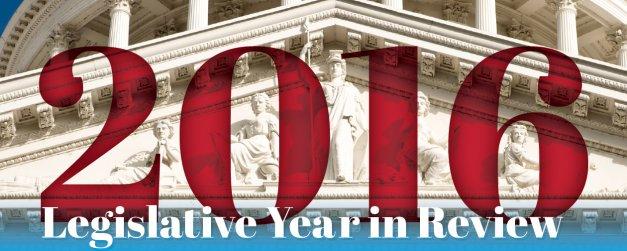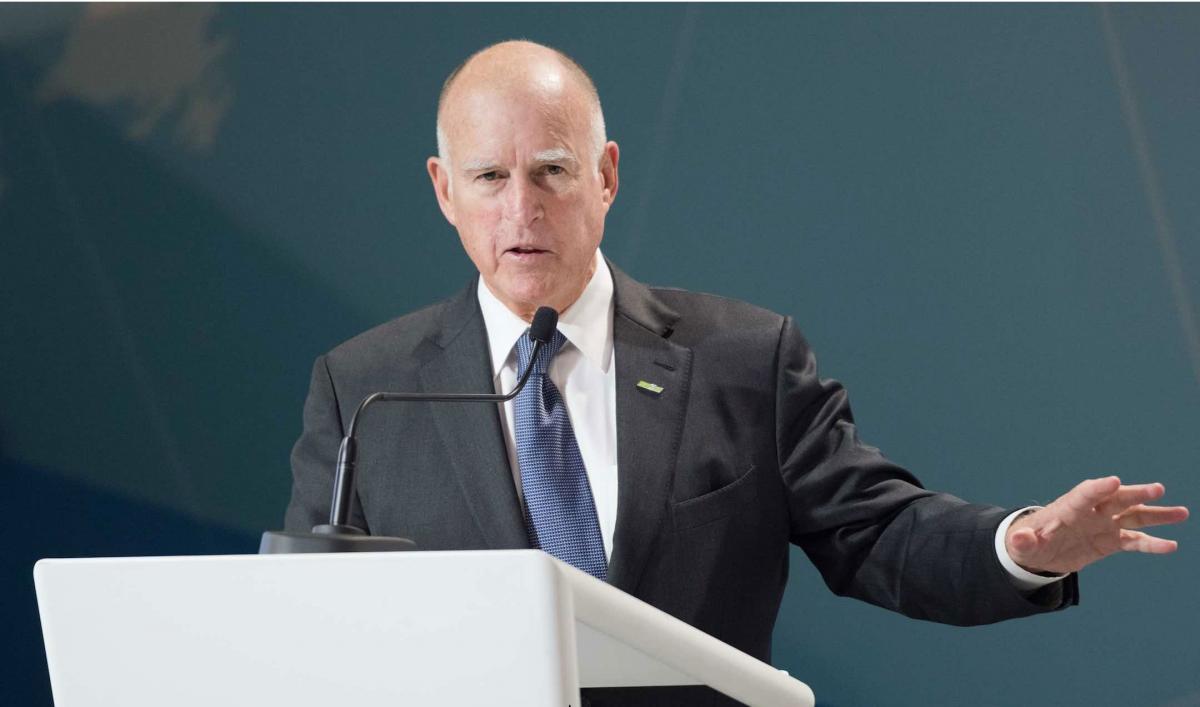2016 Legislative Year in Review
Dan Carrigg is deputy executive director and legislative director for the League; he can be reached at dcarrigg@cacities.org.
Success in California politics can be difficult to define, so perspectives on the 2016 legislative year vary. Those who value a stable and disciplined state budget are pleased because Gov. Jerry Brown again resisted new spending proposals and squirreled away excess revenue into the reserve fund. Advocates for aggressive efforts to reduce greenhouse gas emissions savored victory with the passage of SB 32 (Pavley, Chapter 249, Statutes of 2016), which ratchets up state goals. Labor interests scored major wins, increasing the minimum wage to $15 per hour and requiring overtime for farmworkers. A $2 billion financing plan to help house mentally ill homeless individuals, which the League supported, also succeeded.
Yet other major items remain undone. The goalposts for achieving a major transportation funding package continue to move, the vacuum created in affordable housing funds by the loss of redevelopment remains unfilled, and questions linger about the future prospects of high-speed rail, the Delta tunnels and cap and trade. Despite another chaotic legislative session, however, city officials can be satisfied that the League helped hold the line to preserve local control, revenue and flexibility and made progress in several areas.
Legislative Changes
Term limits continue to change the face of the Capitol as more legislators, now able to serve a total of 12 years in either house, enter office.
In the Assembly, the transition is now complete. In the final hours of the 2016 session, many heartfelt goodbyes and accolades were given to terming-out members subject to six-year limits. This cleared the way for two young leaders — Assembly Speaker Anthony Rendon (D-Lakewood), eligible to serve until 2024, and Assembly Member Chad Mayes (R-Yucca Valley), eligible to serve until 2026 — who are positioned to bring longer-term operational and policy stability to their houses.
In the Senate, a similar transition is occurring at a slower pace. Some former Assembly members, such as former Speaker Toni Atkins (D-San Diego), have been elected to the Senate where they remain eligible, under the former term limits, to serve up to eight years. Established leaders such as Senators Mark Leno, Loni Hancock, Lois Wolk, Bob Huff, Carol Liu and others have now left office. And more change is on the way in the 2017–18 session because Senate Republican Leader Jean Fuller (R-Bakersfield) and Senate President Pro Tem Kevin de León (D-Los Angeles) both term out in 2018.
New Legislative Interactions With Ballot Measures
Recent legislation affecting the state initiative process created new dynamics affecting ballot measures. Those who think 17 measures were too many for the November ballot can thank SB 202 (Hancock, Chapter 558, Statutes of 2011), which required initiative measures to appear only on statewide general election ballots. And SB 1253 (Steinberg, Chapter 697, Statutes of 2014) created new opportunities for the Legislature to interact with and leverage the initiative process.
Prior to SB 1253, legislators were bystanders in the initiative process. They could hold hearings only on initiatives that had qualified for the ballot. These were sideshows with no real political effect, but SB 1253 changed that. Now, after 25 percent of the required signatures are gathered, the secretary of state notifies the Legislature, which may then begin the committee hearing process. Early interaction can now occur between the Legislature and ballot proponents prior to an initiative qualifying; proponents may also pull a measure with the required number of signatures off the ballot within established time frames.
The Legislature’s new role emerged during the 2016 session in debates over raising the minimum wage, the school bond and a legislative transparency measure. On the minimum wage, labor groups had competing proposals headed for the November ballot, and Gov. Brown was concerned about the impacts of a wage increase on the state’s General Fund. Labor groups, however, had leverage because the initiatives polled well. This dynamic resulted in Gov. Brown agreeing to raise the minimum wage via legislation and labor groups pulling their initiatives off the ballot. With the school bond, some legislators attempted to convince the proponents of Prop. 51 to agree to a refocused and smaller bond, but there was insufficient legislative support due to the political strength of the proponents’ coalition. The Democrats also proposed alternatives to Prop. 54, a measure focused on increasing legislative transparency, but failed to succeed when Republicans refused to go along.
Despite these interactions — given its newness, leadership changes and other distractions — the Legislature did not appear to use the leverage provided by SB 1253 to its full potential. But with lessons learned in 2016, look for the Legislature to exercise its new influence over initiative proponents more aggressively next time around.
No Budget Drama
Those looking for drama around the state budget — like past stories of members locked in the chambers and sleeping on desks — will be disappointed. Over the past few years, the budget has become quite predictable. In January, with revenues up over projections, Gov. Brown played contrarian, using historical graphs showing the crazy red-ink days of the past. He rejected new spending expansions and advocated for increasing reserves to prepare for the eventual downturn. He also outlined all the state’s spending commitments that needed to be paid for, including some recently enacted by the Legislature. Republicans generally supported this approach, while Democrats analyzed and questioned Gov. Brown’s numbers and advocated for spending on numerous priorities. But by June 15, after some back-and-forth negotiations, Gov. Brown got what he wanted on spending and boosting the reserves, and everyone left for summer recess.
The roots of this dynamic are based on two things. First, Gov. Brown is determined to preserve his legacy of cleaning up the past state budget mess and leaving office with the state’s improved fiscal condition intact. Second, legislators lost most of their leverage over a governor with the passage of Prop. 25 (2010). For legislative power, Prop. 25 was a two-edged sword — it authorized a majority-vote budget but also required legislators to forfeit their salary for every day the budget is late. In prior battles, a legislator’s pay was just “suspended” until legislators agreed on a budget; they could drag things out and still recoup all their pay. Now they lose it permanently, which makes a big difference.
At $122.5 billion, the 2016 budget was the largest in California’s 166-year history. Nevertheless, the political tone was positive. Though Republicans opposed the budget bill, arguing that it was too big and that the state is not prepared for the next economic downturn, the floor debates were good-natured, and trailer bills passed with bipartisan support. Gov. Brown achieved his objectives with a $2 billion boost for the state’s rainy day reserve (now over $7 billion) and other agreements that limit new and ongoing spending. Democrats secured an additional $100 million for child-care and preschool programs; a funding mechanism to build housing for homeless people (a proposal the League strongly supported) by allowing some Prop. 63 mental health funds to be used to fund a $2 billion revenue bond; the repeal of the monetary limit on welfare payments for people who have more children while collecting welfare; and an investment in clean drinking water.
Overall, the budget agreement was good news for cities. It included $20 million for local law enforcement grants that did not come easily. A lobbying effort conducted in partnership with the California Police Chiefs Association headed off an effort to reduce or eliminate these funds, which will be used to focus on improving interactions with homeless and other high-risk populations. The budget also allocated cap-and-trade funds totaling $1.2 billion, of which $400 million went to affordable housing in sustainable communities and other allocations to transit and high-speed rail. Gov. Brown rejected a proposal by Assembly Democrats for $1.3 billion for affordable housing, then countered in the May Revise with a “by right” proposal that would limit public engagement, design and environmental review related to certain housing projects in exchange for a one-time $400 million allocation for affordable housing construction. Labor, environmental groups and cities opposed the loss of public engagement and environmental review, and the Legislature did not include it as part of the budget.
Transportation
When 2016 began, prospects were bright for reaching agreement on a transportation funding package — legislators had various proposals, Gov. Brown’s special session was still in effect and everyone agreed the problem needed to be solved. Nevertheless, the session ended in August with nothing having been accomplished, but not due to a lack of effort. The League and other stakeholders in the Fix Our Roads Coalition participated in numerous meetings, press conferences, legislative briefings and social media campaigns as the months passed. Other priorities eclipsed transportation funding — first, it was straightening out the managed care organization tax issue, then it was the minimum wage agreement, then the budget, then limitations on access to ammunition and guns, and then the summer recess.
In August, however, some progress occurred when the chairs of the Senate and Assembly Transportation Committees, Sen. Jim Beall (D-San Jose) and Assembly Member Jim Frazier (D-Oakley), introduced legislation into the Special Session on Transportation that would generate $7.4 billion annually for the state’s transportation network. This total included $2.5 billion for local streets and roads. Supported by the League, SBx1 1 (Beall) and ABx1 26 (Frazier) mirrored each other and offered a balanced approach to funding road maintenance and repair coupled with significant reforms. After the Legislature adjourned the 2015–16 regular session, the special session continued until Nov. 22, but no transportation funding deal was reached. The governor and legislative leaders committed to continue efforts in 2017.
The Fix Our Roads Coalition, which the League co-founded, continues working with legislators and stakeholders to pass a workable and sustainable transportation funding package. Cities should remain focused on transportation issues and watch for updates from the League.
Housing
What a difference a few years make in boom-and-bust California. Seven years ago the unemployment rate was double digit, and many homeowners were “upside down” on equity. Short sales and foreclosures were everywhere. Prices were discounted up to 40 percent, which made purchasing a home “affordable” for many households. Since then, prices skyrocketed as the state recovered from the recession — especially in coastal areas where a high-tech job boom created bidding wars for well-paid employees jockeying to live in the best locations. But in the Central Valley and Inland Empire, housing affordability remains more realistic and reflects a less robust economy, higher unemployment rates and a slower recovery.
The massive withdrawal of resources for affordable housing contributed to this affordability crisis. With the elimination of redevelopment agencies, local agencies lost over $5 billion for affordable housing since 2011 — with no foreseeable significant source of ongoing affordable housing funding. The proceeds of the 2006 state housing bond are also gone. Compounding these factors, the federal government has been backing out of funding affordable housing since the 1980s. Despite the state budget flourishing in recent years due to infusions of income tax, no significant funds (other than some cap-and-trade dollars) have been allocated for affordable housing.
The League appreciates the leadership of Sen. Jim Beall and Assembly Member David Chiu (D-San Francisco) as chairs of the Senate and Assembly Housing Committees, who have been advocating for affordable housing funding. Assembly Member Chiu championed a $300 million expansion in state housing tax credits and led his caucus in an effort to secure a one-time allocation of $1.3 billion in state surplus budget funds. Sen. Beall proposed a $3 billion housing bond. Former Speaker Toni Atkins proposed that half of the state’s savings from eliminating redevelopment should go to affordable housing.
Regrettably all these efforts supported by the League stalled, and the last half of the session was spent sparring over Gov. Brown’s “by right” housing proposal, which proposed to limit public engagement, design and environmental review related to housing projects with minimal amounts of affordable housing. Due to legislators’ concerns over this aggressive effort to undermine state environmental policies, laws and public input — and strong opposition from labor, environmental groups and the League — the effort failed to gain traction.
One bright spot in affordable housing was the passage of the No Place Like Home measure led by Senate President Pro Tem de León, which earmarks a portion of Prop. 63 mental health dollars to fund a $2 billion revenue bond to help house homeless people with mental illness. The League recognized Senator de León as its Legislator of the Year for his efforts.
Other legislators tinkered with various aspects of local planning and land use, including tightening laws affecting litigation over denied projects, another set of changes to the Density Bonus Law, housing elements and second units. Though the League was able to secure amendments and take a neutral position on most of these measures, it remained opposed to SB 1069 (Wieckowski, Chapter 720, Statutes of 2016), which undercut local parking requirements associated with second units and was signed into law by Gov. Brown.
With another robust discussion of affordable housing anticipated in 2017, cities should be prepared to continue defending against efforts to dictate land use from the state level and erode the role of community-based planning. The League hopes some of the incentive-based concepts that it floated in 2016 will gather momentum, such as:
- Establishing a state revolving fund that can be used to update Specific Plans and complete upfront environmental reviews on targeted housing sites adjacent to transit and areas consistent with SB 375 (Steinberg, Chapter 728, Statutes of 2008). Such a process would allow for full community engagement and environmental analysis. Following that, development of those parcels would be expedited via existing laws;
- Rewarding local agencies that approve higher density housing in designated areas by helping it “pencil out” against service costs by shifting 10 percent of the increased property tax accruing from the approved development to the approving city or county;
- Developing a state-local matching funding program for infill development-related infrastructure that more adequately fills the gaps in urban renewal tools left by the loss of redevelopment; and
- Establishing a real, substantial and ongoing source of affordable housing funding.
Environmental Issues
2016 was all about greenhouse gas reduction and cap and trade. Environmental groups celebrated a major victory when an agreement was forged to increase the state greenhouse gas reduction goals. Though cap-and-trade funds were allocated, the program’s future remains uncertain.
After a similar effort stalled on the Assembly floor in 2015, a compromise was reached as SB 32 (Pavley, Chapter 249, Statutes of 2016) and AB 197 (E. Garcia, Chapter 250, Statutes of 2016) cleared final legislative hurdles in the face of strong opposition from business groups, oil companies and agricultural interests.
SB 32 provides the California Air Resources Board (CARB) with authority to limit statewide greenhouse gas emissions equivalent to at least 40 percent below 1990 levels by 2030. However, SB 32 does not explicitly extend the cap-and-trade program. Gov. Brown unsuccessfully attempted to insert last-minute amendments into SB 32 to clarify that the program shall continue beyond 2020.
AB 197 establishes a new Joint Legislative Committee on Climate Change Policies to provide ongoing, permanent oversight of the implementation of the state’s climate policies and the Greenhouse Gas Reduction Fund. The committee comprises at least three senators and three Assembly members. The bill also made substantial changes to CARB by imposing six-year term limits on voting members and adding two members of the Legislature as nonvoting ex officiomembers, one appointed by each house.
Uncertainty continues about the cap-and-trade program’s future in light of a steep decline in revenues from recent auctions and a pending court case challenging the legitimacy of the funds absent a legislative two-thirds vote. At a press conference announcing the passage of SB 32 and AB 197, journalists asked Governor Brown about the fate of the cap-and-trade program. He said SB 32, which empowers CARB to force greenhouse gas emitters to take action or face penalties, provides leverage to lawmakers to reach a deal with opponents of the cap-and-trade program who would prefer such a program over more rigorous regulations to reduce pollution. Gov. Brown warned, “They’re going to plead for a market system.”
With SB 32’s aggressive reduction goals now in place, major regulatory battles and debates over their economic impacts can be expected in 2017 as the tension increases between these goals and practical and fiscal realities.
Though disputes continue over the program’s overall fate, the Legislature succeeded in allocating $900 million in discretionary funds that had accumulated over a two-year period and passed AB 2722 (Burke, Chapter 371, Statutes of 2016), a measure that establishes the programmatic framework for the new Transformative Climate Communities Program (TCCP), which received funding from the cap-and-trade expenditure program. The TCCP is very similar to a program that the League, the California State Association of Counties (CSAC), the Local Government Commission and others have advocated for during the past three years. The TCCP provides funding to develop and implement neighborhood-level climate community plans that include multiple coordinated greenhouse gas emissions-reduction projects that provide local economic, environmental and health benefits to disadvantaged communities. Gov. Brown also signed AB 1550 (Gomez, Chapter 365, Statutes of 2016), which increases to 35 percent the amount of cap-and-trade auction proceeds that must be spent in disadvantaged or low-income communities.
Two League-opposed measures in related areas ended well after massive lobbying efforts. AB 2693 (Dababneh, Chapter 618, Statutes of 2016) sought to eliminate the senior lien status of Property Assessed Clean Energy (PACE) loans; it was converted into a League-supported measure enhancing existing consumer protections and disclosures and signed by Gov. Brown. SB 1387 (de León) proposed adding additional state appointees to the regional South Coast Air Quality Management District board but stalled on the Assembly floor.
League Initiatives in Other Areas
Elections and voting. The League’s efforts to develop additional options and protections for communities concerned with rampant litigation filed by attorneys alleging violations of the California Voting Rights Act (CVRA) finally produced results. This followed several years of battles over legislation authored by Assembly Member Roger Hernández (D-West Covina), which attempted to mandate that cities with a population over 100,000 shift from “at large” to district election systems. In 2016, however, Gov. Brown’s signature on AB 2220 (Cooper, Chapter 751, Statutes of 2016), a League-sponsored measure, finishes the work started with the passage of SB 493 (Cannella, Chapter 735, Statutes of 2015), which the League also helped shape. AB 2220 provides all cities with the option of switching to districts by ordinance rather than incurring the delays, uncertainties and exorbitant legal fees associated with waiting for the next election. This flexibility is similar to options already available to school districts and community colleges facing CVRA challenges. After months of negotiations, the League also successfully secured amendments to AB 350 (Alejo, Chapter 737, Statutes of 2016) that provide “notice and cure” protections from exorbitant legal fees for communities facing CVRA challenges. The League applauds Gov. Brown, Assembly Members Luis Alejo and Jim Cooper and the wide range of stakeholders who helped forge agreement on these measures.
Economic development. Continued progress on economic development unfolded as Gov. Brown signed AB 2492 (Alejo and E. Garcia, Chapter 524, Statutes of 2016) and AB 806 (Dodd and Frazier, Chapter 503, Statutes of 2016). AB 2492 makes several improvements to the previous year’s AB 2 (Alejo and E. Garcia, Chapter 319, Statutes of 2015), which authorized the creation of the Community Revitalization and Investment Authorities (CRIA) and restored redevelopment authority to local agencies to assist lower-income and deteriorated areas within a community. AB 806 provides additional flexibility to local communities seeking to expand economic development and clarifies that loan, lease and sale agreements and property acquisition are included in the range of options a community may employ to advance economic development; it also allows acquired properties to be disposed of for “fair reuse value.” Regrettably, Gov. Brown vetoed AB 2728 (Atkins), which attempted to extend the sunset date of and make other changes to the California Organized Investment Network (COIN) program that offers tax credits to insurance companies investing in lower-income communities.
Employee relations. Given the significant influence of labor organizations in the Capitol, employee relations policy is always a busy area of activity. League priorities included stopping additional mandates and proposals that increased costs or eroded local flexibility. Though many bills were introduced, concerns were often addressed by collaborative efforts to obtain necessary amendments or by working with coalitions of other public and private employer groups to provide factual information on local costs and policy impacts to decision-makers in the Legislature and governor’s office. This strategy resulted in the most troublesome proposals being neutralized with amendments, stopped in committee or vetoed.
Significant energy was expended on issues related to the U.S. Supreme Court’s 4-4 ruling in the controversial Friedrichs v. California Teachers Association, which challenged the collection of “fair share” or “compulsory” union fees from nonunion employees. Organized labor responded with AB 2835 (Cooper), co-authored by Democratic leaders. The measure was amended in August and would have required that all public employer labor organizations be allowed 30 minutes of paid time to organize new hires. The League and its public employer counterparts strongly opposed the effort. Aside from the loss of local control, concerns included logistical challenges, the estimated $350 million annually that the measure would have shifted to the state, and mandates on local governments and school districts. City engagement, including city participation in League data-collection surveys, played a critical role in educating and informing legislators.
Because of the bills’ potential to increase costs for struggling local agencies, the League appreciated Gov. Brown’s vetoes of SB 897 (Roth), which would have expanded use of paid disability leave for certain public safety workers (often referred to as “4850 time”) for an additional year; AB 1643 (Gonzalez), which would have removed the “apportionment” process for certain non-industrial work injuries; and SB 654 (Jackson), which would have expanded the California Family Rights Act for public and private entities of 20 (instead of 50) employees or more. Gov. Brown signed AB 1244 (Gray, Chapter 852, Statutes of 2016), a helpful measure aimed at decreasing fraud in the workers’ compensation system.
Public works and other transportation issues. While the League focused on the effort to secure additional transportation funds, local control had to be protected in several areas, including AB 2586 (Gatto), which attempted to dictate various aspects of local parking management. Though the measure was amended to remove various provisions, the bill that went to Gov. Brown still had flawed provisions that included micromanaging street sweeping and prohibiting localities from offering incentives for private parking enforcement. The League figured prominently in the effort to convince Gov. Brown to veto the bill. AB 650 (Low), revised several times during the final days of the legislative session, sought to limit local authority over taxi regulation in various ways; the League lobbied in opposition to it and appreciates the governor’s veto of that measure. Gov. Brown’s signature on AB 626 (Chiu, Chapter 810, Statutes of 2016) was a disappointment; it establishes a complex claims resolution process with various timelines and forces mediation when meet-and-confers do not resolve disputes.
Public safety. After the 2015 passage of the comprehensive Medical Cannabis Regulation and Safety Act, many proposals were introduced in 2016 to “clarify” different aspects. The League was active defending provisions important to local government and urging restraint because the regulatory process was barely underway and the voters’ potential approval of Prop. 64, the Adult Use of Marijuana Act, would have many implications. Some cleanup advanced, however, including the League-supported AB 2679 (Cooley, Chapter 828, Statutes of 2016), which expands research activities to include the effect of marijuana on motor skills and provides interim guidance on manufacturing processes.
In other areas, debates over law enforcement relations with communities featured prominently in legislative discussions. Though some aggressive proposals stalled, Gov. Brown signed AB 2298 (Weber, Chapter 752, Statutes of 2016), which requires notification of adults listed on law enforcement’s gang databases. More activity is expected on the gang database issue in 2017. The League opposed AB 1217 (Daly, Chapter 504, Statutes of 2016) over the precedent of state interference in governance of local joint powers authorities by codifying a rule adopted by the Orange County Fire Authority Board; Gov. Brown signed the bill.
Drones. As drone usage increases for commercial, mapping, surveillance and hobbyist purposes, so do the controversies as local governments attempt to respond to issues ranging from privacy and noise to interfering with public safety. In June, the Federal Aviation Administration rejected pre-emption of state and local drone regulation laws and ordinances, stating that “certain legal aspects concerning small UAS (unmanned aircraft systems) use may be best addressed at the state or local level.”
Legislative proposals ranged from efforts limiting local control to enhancing regulation. In April, amendments to AB 2320 (Calderon and Low) pre-empted local governments from enacting ordinances to regulate drones. Lobbyists for DJI, a Chinese drone manufacturer reputed to have the largest U.S. market share of the industry, supported the bill. The pre-emption provision, however, was forced out in the Assembly Committee on Local Government following vigorous opposition from the League and the California Police Chiefs Association.
Later in the session, amendments were floated attempting to enact a moratorium on local regulation until an industry-dominated working group drafted a model ordinance, but the League and police chiefs successfully rebuffed this effort. The drone industry succeeded in stopping several regulatory measures.
Of the minor measures that made it to Gov. Brown’s desk, he vetoed all except SB 807 (Gaines, Chapter 834, Statutes of 2016), sponsored by the League and the California Police Chiefs Association; it provides stronger immunity for local agency first responders who damage or destroy a drone that interferes with their emergency operations. The battles over drone issues are expected to intensify as powerful companies providing products and services seek to clear the airspace of local regulation.
Transparency, open data and cyber-security. Policy-makers are struggling to balance open government policies and increased demands for access to government data with protecting privacy and avoiding disclosures that could expand fraud or reveal public safety vulnerabilities. In 2015 after significant legislative discussion and lobbying, Gov. Brown signed two principal bills in this area. AB 169 (Maienschein, Chapter 737, Statutes of 2015) establishes several standards for information that is described by local agencies on their websites as “open data,” and SB 272 (Hertzberg, Chapter 795, Statutes of 2015) requires local agencies to disclose the software application or computer system that the local agency uses to maintain various information. This year, local agencies focused on implementing those laws, but other related legislation was enacted. After public agencies started receiving fraudulent bills based on information obtained from their websites, the Legislature enacted SB 441 (Wolk, Chapter 477, Statutes of 2016) exempting from disclosure any identification number, alphanumeric character or other unique identifying code used by a public agency to identify vendors or contractors unless the identification number, alphanumeric character or other unique identifying code is used in a public bidding or an audit involving the public agency.
Gov. Brown signed AB 1787 (Gomez, Chapter 507, Statutes of 2016), which requires agencies with time limits for public comment to provide at least twice the allotted time to non-English speakers using interpreters, unless simultaneous translation equipment is used. Complying with public records requests was made easier with the passage of AB 2853 (Gatto, Chapter 275, Statutes of 2016), which allows a public agency to comply with certain disclosure requirements by posting any public record on its website and directing members of the public to the location where it is posted. Gov. Brown vetoed AB 779 (Garcia), which the League opposed; this bill would have required a comprehensive and duplicative report on the components of elected official compensation.
Short-term residential rentals. The proliferation of web-based vacation rental websites as part of the “sharing economy” has provided more options for the traveling public and offered increased income potential for homeowners. Such changes, however, produced new problems that include losing rental housing stock, undermining the quality of life in residential neighborhoods and creating challenges in collecting transient occupancy tax (TOT). Many communities are updating ordinances and revising methods to better identify these units and collect associated revenue. A working group formed by the League in 2013 ultimately concluded that cities were better off working through the issues locally rather than seeking state action.
Legislative action centered around several bills by Sen. Mike McGuire (D-Healdsburg), including SB 593, which the League supported because it preserved local authority by allowing local agencies to “opt in” to a regulatory framework that would provide enhanced revenue collection and access to data. The bill died on the Senate floor in January due to industry opposition. Later in the year, the senator offered alternative industry-supported proposals, SB 1102 and SB 133, which would have established a statewide audit program, governed by the state Controller’s Office, associated with collecting TOT for units offered by online short-term rental platforms. The League and a coalition comprising counties, hotels and hotel workers’ unions opposed the measures based on concerns ranging from state incursions into local revenue to restricted access to data that limited land-use enforcement and other issues. Though progress on these issues stalled in the Legislature, local efforts to adjust to this new industry continue to improve. Updated ordinances and techniques are being developed, and new technologies allow local agencies to more easily identify short-term rental units to ensure they are collecting and remitting TOT and complying with other local requirements.
Stormwater. California’s stringent water-quality laws, coupled with the drought, have highlighted the need for local agencies to have more viable ways of funding the removal of garbage and toxins from stormwater before it flows into streams, rivers and the ocean. Most of the challenges associated with this issue relate to interpretations of Prop. 218 (2006), which excludes “water, sewer and refuse collection” from its more restrictive provisions, but which the courts have interpreted as not excluding “stormwater.” The California Supreme Court’s recent San Juan Capistrano decision ruled that water agencies are prohibited from establishing increased rate tiers as a deterrent to excessive water use. In early 2016 the League, California Association of Counties and the Association of California Water Agencies drafted an alternative process for financing water infrastructure as a proposed ballot measure, but later discontinued the effort when internal polling cast doubts about its potential viability. Later in 2016, Sen. Bob Hertzberg (D-Van Nuys) proposed in SB 1298 a revised definition of “sewer” under Prop. 218 implementation statutes, but he ultimately opted not to move the measure. Gov. Brown signed AB 2594 (Gordon, Chapter 526, Statutes of 2016), which clarifies that a public entity that captures stormwater before the water reaches a natural channel may use the captured water.
Homelessness. With local officials and state legislators increasingly concerned about perceived increases in homeless individuals living on the streets, the League opted to get ahead of the issue after the 2015 session by forming a small working group of key city staff and elected officials to help identify what cities were doing to address homelessness and the tools and resources they needed. In mid-November 2015, when the League’s leadership identified homelessness as part of its 2016 strategic priorities on housing, policy development efforts on homelessness were already underway. This effort also contributed to documents, developed by the League’s Public Affairs staff, that provided positive information to legislators about cities’ efforts and the needed resources. These activities helped better position the League for a volatile legislative year.
The League successfully defeated several attempts to remove local control while supporting various pieces of legislation that helped address the issue. These included Sen. de León’s No Place Like Home measure that will result in $2 billion in additional affordable housing resources targeting one of California cities’ most difficult problems: helping provide shelter and assistance to homeless individuals with mental illness by constructing 10,000 new housing units, which will be accompanied by services.
The League and CSAC formed a joint Homelessness Task Force in fall 2016 to identify best practices, promote city-county collaborative efforts and recommend policy changes that can help local agencies address homelessness.
Future of city formation. Gov. Brown vetoed SB 817 (Roth), the latest in a repeated effort to restore funding stability to four recently incorporated cities in Riverside County. The veto continues the funding challenges for these cities created by SB 89 (Chapter 35, Statutes of 2011), which diverted critical Vehicle License Fee (VLF) revenues away from newly incorporated cities and compounded the challenges facing future incorporations. The issues raised by SB 817 also touch on larger policy issues. When SB 89 was adopted as part of the response to the budget crisis in 2011, it also undermined the economic viability of future incorporations.
The typical pattern of city formation has involved pockets of development that begin in unincorporated areas, followed by residents pursuing city formation at some point to better manage their community. From a state policy perspective, neglecting this issue is not without consequences, because city formation supports and advances compact growth. When cities are established, their future growth is regulated by Local Agency Formation Commission (LAFCO) policies. In contrast, unincorporated development patterns are typically less dense and not regulated by LAFCO. The League looks forward to establishing a dialogue with Gov. Brown’s administration to further discuss the role of new city formation in the state’s future and new cities’ contributions to sustainable development patterns and local quality of life.
Governor’s Final Actions
Gov. Brown closed out the 2016 session on Sept. 30 by signing and vetoing legislation sent to him by the Legislature. Overall the news was mostly positive for cities. Gov. Brown agreed with the League’s position 76 percent of the time. He signed 25 of the 31 bills on which the League requested signatures and vetoed seven of 11 veto requests.
Major positive outcomes for the League included his signature on several bills providing flexibility and helping to reduce legal costs associated with implementing the Voting Rights Act, including AB 2220 (Cooper) and AB 350 (Alejo); helpful economic development bills AB 2492 (Alejo and E. Garcia) and AB 806 (Dodd and Frazier); and two budget trailer bills implementing the homeless assistance measure, No Place Like Home. He also vetoed numerous bills that would have undermined local authority over issues such as parking, in AB 2586 (Gatto), and taxis in AB 650 (Low), and other measures proposing to expand workers’ compensation benefits. Disappointments included Gov. Brown’s signature on SB 1069 (Wieckowski, Chapter 720, Statutes of 2016), which restricts a local agency’s ability to impose parking requirements on second units (now named “accessory dwelling units”), and AB 626 (Chiu, Chapter 810, Statutes of 2016) regarding construction claim resolution processes.
Issues for 2017
The 2017 legislative session will bring unknown elements, especially in the interaction between the California Legislature and President-Elect Trump’s administration on tension points of immigration, health care and climate change. Opportunities may exist, however, to work with the new federal administration on rebuilding the nation’s infrastructure, tax reform or trade policies. Questions also remain on how the new administration will view recreational marijuana, including the recently approved Prop. 64.
Certainties include a continued policy discussion on how to address the state’s needs for affordable housing and assist homeless people, regulatory efforts to implement greenhouse gas emissions reduction goals at CARB, the rollout of Prop. 64 and restoring the economic reliability of the state’s recycling programs.
The state budget and the sustainability of California Public Employees’ Retirement System (CalPERS) pensions raise other questions. State revenues depend heavily on income tax and particularly on the fortunes of the wealthy. The stock market is volatile and unpredictable. Discussion continues about the sustainability of the CalPERS pension system and the need to reduce the CalPERS discount rate (which is based on the expected rate of investment return), which would result in requiring public employers to increase their contributions.
Democratic supermajority control of the state Senate and Assembly has the potential to affect policy decisions concerning taxation, placing measures on the ballot and enacting urgency legislation that takes effect immediately.
Whatever comes, the League will continue advocating for resources and partnerships with local agencies, other organizations, the business community and the state and federal governments to assist cities in responding to urgent infrastructure and affordable housing needs, protecting public safety and providing vital services that enhance the quality of life for their residents. The League remains a staunch advocate for the benefits of local control and flexibility.
Positioning Your City for Advocacy in 2017
“A Look at the League’s 2017 Strategic Priorities” highlights what’s ahead for California cities this year. For an overview of helpful advocacy tools and activities that your city can participate in, read “What You Need to Know About Legislative Advocacy and the League.”
Plan Now for Legislative Action Day
Set time aside now to attend the League’s Legislative Action Day event in Sacramento on Wednesday, April 19, 2017. Hear from legislators, state leaders and League staff about the latest developments affecting cities. Meet with your legislators following the presentations to discuss your city’s priorities and concerns. (Schedule your appointments well in advance.)
Photo credits: Sheila Fitzgerald/Shutterstock.com (bulldozer); Alexmisu/Shutterstock.com(houses); Ben Heys/Shutterstock.com (lake); Alexey Yuzhakov/Shutterstock.com(drone); ArielMartin/Shutterstock.com (stormwater); Frederic Legrand – COMEO/Shutterstock.com(Gov. Brown)
This article appears in the January 2017 issue of
Western City
Did you like what you read here? Subscribe to Western City







